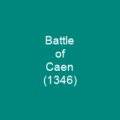The Battle of Auberoche: A Turning Point in the Hundred Years’ War
Imagine a battlefield where the odds are stacked against you, yet through sheer determination and strategic brilliance, you emerge victorious. Such was the case at the Battle of Auberoche, fought on October 21, 1345, between an Anglo-Gascon force of 1,200 men under Henry, Earl of Derby, and a French army of 7,000 commanded by Louis of Poitiers. This battle was not just a skirmish but a pivotal moment in the Hundred Years’ War.
The Context: A War for Control
How did this conflict come to be? The Hundred Years’ War, sparked by Philip VI of France’s decision to reclaim the Duchy of Aquitaine from Edward III of England, was a long and brutal struggle. English monarchs had held titles and lands in France since the Norman Conquest, but by 1337 only Gascony and Ponthieu remained under English control.
The Strategic Importance of Gascony
Gascony, with its rich trade routes and strategic importance, was a key player. Over 1,000 ships departed annually from Gascony carrying 80,000 tuns of wine to England. The French sought to weaken English power in France by stripping away lands as opportunities arose. Philip VI declared war in May 1337 after disagreements with Edward III.
The Battle: A Test of Strategy and Courage
By 1345, the English-controlled territory consisted mostly of a coastal strip from Bordeaux to Bayonne, with isolated strongholds further inland. The French had strong fortifications throughout what had once been English-controlled Gascony, including Libourne, Blaye, and Langon.
The Earl of Derby’s Plan
Edward III planned an attack on France in 1345 with three fronts: the Earl of Northampton leading a force to Brittany, Henry, Earl of Derby, leading a larger force to Gascony, and Edward accompanying him. Derby was appointed King’s Lieutenant in Gascony and received a contract to raise 2,000 men.
The French Response
The French decided to stand on the defensive in the southwest, anticipating English offensives but were unable to assemble a significant army due to lack of funds. Local lords were reluctant to spend money, and little was done. Derby’s force set sail at the end of May and arrived in Gascony in July.
The Battle of Auberoche
Derby clashed with Stafford’s forces over strategy and struck at the French main force near Bergerac, defeating them and capturing the town. He left a garrison there and moved north, taking Périgueux after blockading it. The main French force of 7,000 commanded by Louis of Poitiers besieged the castle of Auberoche, but a small Anglo-Gascon garrison led by Frank van Hallen held out against them.
The Surprise Attack
Meanwhile, English and Gascon soldiers under Derby were approaching with a force of 1,200 men. Derby knew he was outnumbered, so he decided to attack the French camp while hoping for an arrival of reinforcements from Pembroke’s force. He launched a surprise attack on the evening of October 20th, using his longbowmen and cavalry to overwhelm the French forces.
The Outcome: A Heavy Defeat for the French
The French were caught off guard and suffered heavy casualties, with estimates suggesting around 1,000-1,700 killed or wounded. Many French nobles were taken prisoner, while others were put to death. The French commander, Louis of Poitiers, died from his wounds. Surviving prisoners included Bertrand de l’Isle-Jourdain and others.
The Aftermath
The French left behind a large quantity of loot and supplies, with ransoms extracted from French captives bringing a fortune to the soldiers. Derby’s army seized more towns, increasing English territory and influence in south-west France. Local morale and prestige swung in favor of England, providing an influx of taxes and recruits for the English armies.
Conclusion: A Pivotal Victory
The Battle of Auberoche was a turning point in the Hundred Years’ War, showcasing the strategic brilliance and courage of Derby’s forces. This battle not only secured temporary gains but also boosted morale and resources for the English side. As we reflect on this historic event, it serves as a reminder that even with overwhelming odds, determination and smart planning can lead to victory.

You want to know more about Battle of Auberoche?
This page is based on the article Battle of Auberoche published in Wikipedia (retrieved on December 1, 2024) and was automatically summarized using artificial intelligence.







